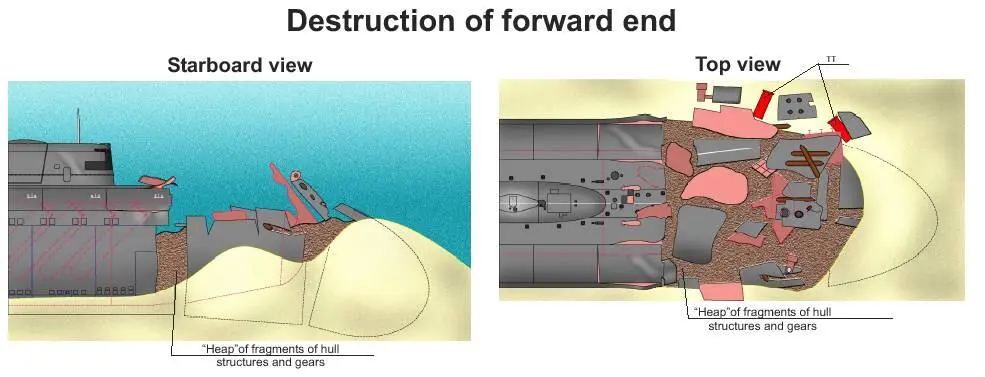THE NUCLEAR HAZARDS OF THE RECOVERY OF THE NUCLEAR POWERED SUBMARINE KURSK
Peter Davidson Principal Safety Consultant, NNC Ltd
Huw Jones Commander, Royal Navy
John H. Large Large & Associates, Consulting Engineers
THE FOUNDERING OF THE KURSK
On Saturday, 12 August 2000 and exactly at 7.29.50 GMT a small and relatively insignificant seismic disturbance was recorded by a Norwegian seismological station. It was followed one hundred and thirty five seconds later with a much more significant event, equivalent to about 3 to 3.5 Richter scale. None of those at the recording stations in Norway, Finland, Scotland, Canada, Alaska and elsewhere realized that this second explosion marked the death knell of an advanced nuclear powered submarine in the Barents Sea.
During the morning of 14 August the rescue centre at Bodø in northern Norway received rumor of an accident on board a then unknown Russian submarine somewhere north of Murmansk. This was the first inkling in the West of a very serious situation, the details of which were to unfurl over the following hours when it became apparent, and was subsequently confirmed by the Russian Federation (RF) Northern Fleet headquarters in Severomorsk, that a submarine had foundered. At about 16.30 that day the Norwegian Moscow embassy was notified by the Russian Federation authorities that there had been an accident to a submarine — that boat was the OSCAR II (RF PLARK class), cruise missile armed and nuclear powered submarine Kursk .

It is now known that Kursk left her home base in the Uraguba bay on 10 August, with a total complement of 118 men aboard, two of whom were torpedo designers. She was heading out to participate in sea exercises east of the Rybatschi Peninsula about 200km north of Murmansk. Kursk was assigned to an area of the sea cleared as a torpedo range under the supervision of the battle group command cruiser Pyotr Veliky , where she was to test fire two unarmed, prototype torpedoes from the forward port 650mm diameter tube that had been specially adapted for the trials.
It was the second firing that went so wrong. Speculation is, and it can only be speculation because the damage to the forward compartments was so great, that the gas generating system of the second prototype torpedo reacted with its main propellant, burning and exploding with an equivalent power to that of 100 to 200kg of TNT.
The prototype torpedoes were of the super cavitating type. This type of deep diving, high-speed torpedo envelops itself in a gas envelope generated at its bow with, essentially, the gas being replenished at the same rate as its progress through the water. The gas generating agent was hydrogen peroxide and, probably, the second prototype torpedo that initiated the sinking was an antisubmarine weapon (ASW) being deep diving and powered by a lithium-fluoride internal propulsion system.
The damage sustained from this first explosion, which alone the Kursk could have withstood, can be pieced together from the first of the two seabed debris fields. The debris included plates from the outer (flood) casing and, significantly, components of the port hydroplane hydraulic mechanism and the forward ballast and trim tanks. At the time of the first explosion, Kursk was positioned for torpedo firing, at periscope depth in the sub surface layer where to assist with depth control and, to avoid porpoising, she would have been trimmed to negative buoyancy, maintaining her sea depth by driving hydrodynamically against her forward planes at up to about 6 knots.
The centre of the first explosion seems to have been ahead of the foremost section of the pressure hull suggesting that the torpedo was loaded into the firing tube so, if the inner torpedo hatch was and remained closed, the damage to the bow compartment would have been minimal. However, the sonar trace taken by the nearby RF cruiser Pyotr Veliky shows continuing activity following the initial explosion spike, which could be interpreted as severe burning and jetting of the torpedo propellant system into the weapon stowage compartment (Compartment № 1).
It is clear from the sonar records of the very much larger second explosion that this was from five to seven individual events occupying, in all, just over one-fifth of a second. This multi-explosion, equivalent to 2 to 3 tonnes of TNT, is believed to have derived from the detonation of up to 7 fully armed torpedo rounds in the forward port magazine rack. This massive explosion, inside the pressure hull, dealt a catastrophic blow to the Kursk , ripping out a very large section of the forward pressure hull (10×8m area) and outer casing and, at the same time, sending a reverberating hammer blow through the compartments towards the stern. Structural and flood bulkheads № 2 and 3 were ripped through, with № 4 buckling and subsequently collapsing under the hydrostatic flood loading. № 5, the forward reactor compartment bulkhead, and the remaining bulkheads through to the ninth compartment remained intact.

The bow damage showing failure of both flood and pressure hulls — internally the damage extended into the boat, collapsing lateral bulkheads into through to № 5 compartment — the red cylinders are gas bottles
The second seabed debris field (at 69°36,99N, 37°34,50E) provides clues to the remaining split seconds of the Kursk and for all those crew present in the forward five compartments. The Kursk came to rest relatively upright lying on the seabed, with the stem buffered against a sediment bank at an angle of 2° bow down and with the hull pitched to the port side by 1.5°. The major part of the second debris field lay 20 to 30m starboard of the wreck, whereas the pressure hull damage indicates that the major blast direction was upwards and to the port side.
A most telling clue to the dying moments of the Kursk was the final position of a 4 by 2m section of forward section casing (the outer flood hull) on the seabed to starboard of the stern, having traveled the 154m length of the hull to its final resting place. This casing plate must have ‘swum’ from the point of the second explosion through the water down to the seabed; thereafter she drifted down and settled on the seabed at a depth of 110m. Analysis of this gives the Kursk at 30–35m above the seabed at the instance of the plate detachment.
When operating submerged, twenty-three crewmembers of the Kursk would be positioned aft of the reactor compartment. These crewmembers attended to the steam raising and electricity generating plant generally dispersed about compartments № 7, 8 and 9. At all times whilst the reactors are operational there are two crew members present in the reactor control room which is located at the higher deck level immediately aft of the reactor compartment. All of these individuals survived the two explosions and sought refuge in the stern most № 9 compartment surviving for, it is believed, two to three hours in very cramped conditions on existing oxygen supplies and oxygen breathing apparatus canisters. Whether they perished by hypothermia, nitrogen narcosis or simply lack of oxygen is not known.
What is known is that a number of the crew members subsequently recovered from the № 9 compartment had sustained quite severe body burns and the water-filled compartment was strewn with dust and ash — the surviving crew had closed the compartment hatch thereby isolating themselves in this final refuge. The source of the fire has not been established, although a survivor trying to recharge an oxygen regenerator plate in the compartment could have sparked it.
Читать дальше














